The German Edge Cloud education series
 Brownfield developmentRead more
Brownfield developmentRead more
is a term used to describe a scenario where new software systems need to be developed and provided for certain tasks while older pre-existing software applications or systems need to be retained. This means any new software architecture will have to factor in these legacy systems and coexist with them. An example of a brownfield system would be a factory or production plant that is already built and has been in operation for some time. The “brown field” in question is a field that has already been built on. A brownfield approach within the context of Industry 4.0 would be the digital transformation of an existing production plant.
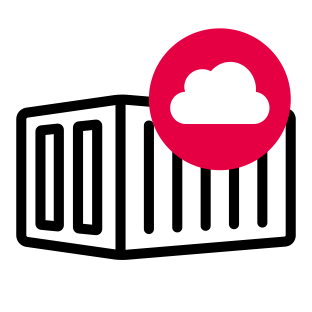 CaaSRead more
CaaSRead more
(Container as a Service) lies between IaaS and PaaS. CaaS is a cloud service that gives customers a ready-made container environment that includes high availability, orchestration, integration into CI/CD pipelines and an image repository. Users can provide and manage applications via container-based abstraction using local data centres or the cloud. CaaS is ideal for developers who produce containerised apps that need to be more secure and also scalable.
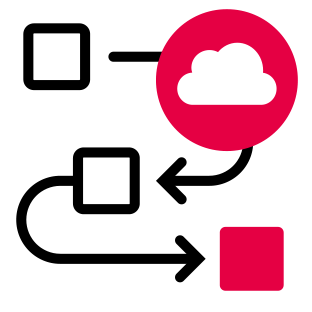 Cloud automationRead more
Cloud automationRead more
is the practice of using technologies to ensure tasks can be run on a largely automated basis and to pool cloud management processes. Cloud automation thus aims to eliminate the manual tasks associated with infrastructure provision, configuration management and the testing and release of applications. This helps to support cloud-native development, establish DevOps principles and much more besides.
 Cloud computingRead more
Cloud computingRead more
makes it possible to provide computing resources and/or an IT infrastructure over the internet, i.e. in the cloud. It usually comprises storage capacity, computing power and application software as a service, all of which is billed based on actual usage. Potential benefits include the flexible use of resources, scale effects and lower operating expenses.
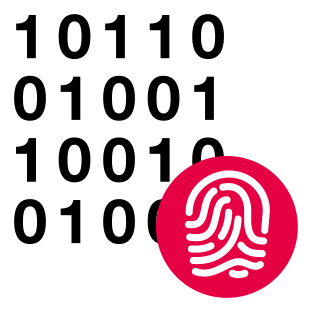 Data sovereigntyRead more
Data sovereigntyRead more
means having ownership of, and maximum control over, your own data. It includes various aspects of empowering people or societies to define how their data is handled. Data sovereignty puts the autonomy of data owners at the heart of everything. It is the owners who decide who is permitted to use their data, how and for what purpose.
 Digital twinsRead more
Digital twinsRead more
are virtual depictions of real objects or processes. Whether the real-life counterpart of a digital twin already exists or is to be created at some point in the future is not important. Digital twins give companies a means of creating a virtual representation of an actual process, product, plant or entire production line. This means, for example, that potential scenarios can be simulated to predict outcomes. As this is all taken care of on a virtual basis, there is no detrimental impact on actual production operations. This ensures, for instance, that potential faults or critical areas can be identified before they become actual physical processes. Simulations and visualisations based on a digital twin offer a means of improving product quality, increasing process efficiency and supporting learning and decision-making processes.
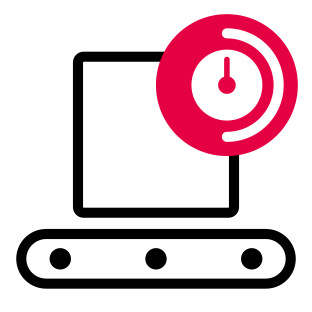 Distributed Control Systems (DCS)Read more
Distributed Control Systems (DCS)Read more
are used to run the automated industrial plant employed in discrete manufacturing and production processes. They are digital systems that control complex plant and machinery. DCS are frequently used for larger plant. They usually consist of solutions for controlling actuators and capturing measured values, visualising plant, recording the curves of analogue measured values and an alarm system.
 Edge cloud appliancesRead more
Edge cloud appliancesRead more
incorporate the hardware, infrastructure and platform layers needed to analyse and process data at the edge of the network, without any major delay and within a dedicated edge cloud. High-volume data (big data) are deleted after the first analysis and only the findings derived from that data (smart data) that are important for subsequent use are retained in the edge cloud appliance or forwarded to private or public clouds. This on-site data selection process eases the strain on systems and also puts users firmly in control of their own data.
 Edge computingRead more
Edge computingRead more
is decentralised data processing at the edge of a network. Data is processed directly at the periphery of the network and therefore at the place where it is originally generated. This means that both transmission and response times are minimised and data can be processed very quickly. As a result, data can be made available almost in real time, which is a crucial prerequisite for state-of-the-art digital processes with data sovereignty. Edge computing also reduces data throughput and bandwidth usage in the network and avoids bottlenecks.
 Gaia-XRead more
Gaia-XRead more

is a project aimed at establishing an efficient, competitive, secure and trustworthy data infrastructure for Europe. Representatives from the federal government and scientific and business communities in Germany and other European partners initiated the project, which is managed by an international, not-for-profit entity. The aim is to build a networked data infrastructure that meets the highest demands in terms of digital sovereignty and promotes innovation. An open and transparent digital ecosystem is to be created so that data and services can be made available, combined and shared with confidence.
 Hybrid cloudsRead more
Hybrid cloudsRead more
combine public and private clouds seamlessly into one integrated infrastructure. A hybrid cloud is used in scenarios where a company’s requirements cannot be met by a single cloud solution. A hybrid cloud is typically a private cloud that is extended with a cost-effective public cloud.
 IaaSRead more
IaaSRead more
(Infrastructure-as-a-Service) is a computing infrastructure that can be put to immediate use and is provided and managed via a public, private or edge cloud. IaaS is the bottom layer of the three layers in a cloud stack, and comes below Software-as-a-Service (SaaS) and Platform-as-a-Service (PaaS). The data centre infrastructure provided incorporates components such as server, computing, network and storage capacities and systems for archiving and data backup. IaaS is usually billed based on usage.
 IIoT platformsRead more
IIoT platformsRead more
are used in industry to connect together physical and virtual “things”. They are employed for a range of purposes, such as capturing, analysing and visualising data in order to optimise processes, for instance through the use of various information and communication technologies. IIoT platforms provide applications that can be utilised to monitor, manage and control networked devices or systems. They are the technological foundations for developing and delivering intelligent applications that can depict operationally relevant instructions almost in real time based on data and metrics.
 Industrial analyticsRead more
Industrial analyticsRead more
is the process of capturing, analysing and utilising data that is generated in production and over the course of a manufactured product’s entire life cycle. It uses both traditional methods of data analysis and machine learning processes. Data is analysed and interpreted with the aim of achieving transparency and optimising factory processes and products.
 Industrial Internet of Things (IIoT)Read more
Industrial Internet of Things (IIoT)Read more
refers to the use of IoT technology in an industrial context. Unlike IoT, IIoT does not represent consumer-focused concepts, focusing instead on leveraging the Internet of Things in a manufacturing and industrial environment.
 Industry 4.0Read more
Industry 4.0Read more
refers to the fourth industrial revolution, a process that is increasingly intertwining the real and virtual worlds. Industry 4.0 stands for the use of information and communications technology to intelligently network machinery and processes in industry. One of the most important elements in this is sharing data in order to implement self-managing production operations and optimise the entire value chain. It is only when everyone involved in production and the value chain has the right information at the right time that crucial decisions can be made and production processes optimised.
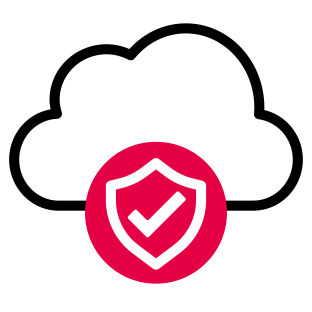 International Data Spaces (IDS)Read more
International Data Spaces (IDS)Read more
(formerly Industrial Data Space) is an initiative that aims to create a secure cross-domain data space. It is based on a reference architecture model that has been developed by 12 Fraunhofer institutes as part of a research project funded by the German Federal Ministry of Education and Research. The IDS architecture of International Data Spaces allows users to share data in a secure data space and restricts the use of that data to an agreed purpose. The International Data Spaces initiative is currently being led and developed by the IDSA (International Data Spaces Association).
 KubernetesRead more
KubernetesRead more
also known as K8s, is an open-source platform originally developed by Google that is used for the orchestration of container systems. The platform automates the setup, operation and scaling of containerised applications. The software is responsible for managing containers and not for creating them. The architecture is based on the master and slave principle – a concept that regulates the communication of several applications, processes and devices and their access to resources. The master is responsible for the control function and grants one or more slaves the right to utilise resources and communicate.
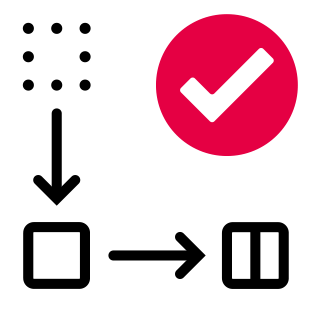 Manufacturing Execution Systems (MES)Read more
Manufacturing Execution Systems (MES)Read more
are an aspect of operational production management. For example, they support production planning and management, order management, staff deployment planning and much more besides. An MES acts as the link between ERP and the shopfloor. Manufacturing Execution Systems are deployed as a means of providing and using information (about the availability of resources and materials, delivery deadlines, etc.) in order to optimise processes and minimise errors, among other things.
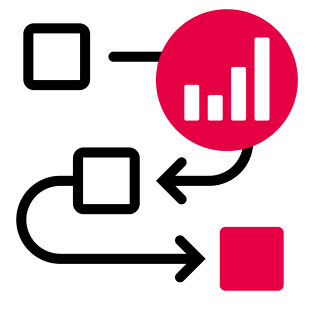 MOMRead more
MOMRead more
(Manufacturing Operations Management) is a fully comprehensive production management system that gives users a complete insight into manufacturing processes. The aim is to ensure the performance of production processes can be continuously improved. An MOM system takes a Manufacturing Execution System (MES) to the next level by consolidating all production processes in order to optimise procedures in quality management, extended production planning and scheduling, manufacturing execution systems and other areas.
 Multi cloudRead more
Multi cloudRead more
describes the parallel use of cloud services and platforms from multiple providers. From the user’s perspective, this arrangement is no different from a single, large cloud. A multi cloud can integrate several cloud models such as private and public clouds. A multi-cloud infrastructure comprises at least two different clouds. The background is that cloud services from different providers cover various usage requirements. This means users do not need to choose just one variant and can instead select a suitable cloud for each different task and then manage all the services in one organisational structure at the end.
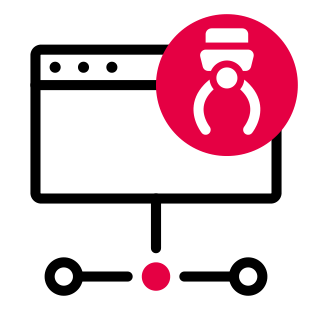 OPC Unified Architecture (OPC UA)Read more
OPC Unified Architecture (OPC UA)Read more
stands for Open Platform Communications and is one of the most important communications protocols for Industry 4.0. UA, or “Unified Architecture”, is the most recent specification of the standard. Together, they form a standard for data exchange as a platform-independent service-oriented architecture (SOA). OPC UA differs from previous generations primarily because it is not dependent on any particular platform. Furthermore, the technology can be used not just to transport machine data but also to describe it semantically on a machine-readable basis.
 Operational technology (OT)Read more
Operational technology (OT)Read more
refers to the hardware and software used to manage, monitor and control physical devices such as machinery and industrial plant and the processes associated with them.
 PaaSRead more
PaaSRead more
(Platform-as-a-Service) is a cloud environment that provides a platform for developing applications in a public, private or edge cloud. PaaS builds on the concept of IaaS (Infrastructure-as-a-Service) and provides services for rapidly deployable runtime or development environments. This means, for example, that web developers can easily develop new applications without having to procure corresponding hardware or software.
 Private cloudsRead more
Private cloudsRead more
are a demand-based cloud provision model. Cloud computing services and infrastructure are hosted “privately” via an in-house intranet or data centre. A private cloud can thus be hosted on computers belonging to the company itself or by a third party and offers a high level of control and security. However, managing a private cloud requires more IT expertise than using a public cloud.
 Product Lifecycle Management (PLM)Read more
Product Lifecycle Management (PLM)Read more
is a concept for seamlessly integrating and managing all the information generated over the course of a product’s entire life cycle. Production information is pooled via a software system and support is provided for developing, producing, monitoring and disposing of resources in the production process.
 Public cloudsRead more
Public cloudsRead more
are an offering from freely accessible providers who make their services openly available to everyone over the internet. Examples include hyperscaler platforms such as Microsoft Azure, Amazon Web Services, Google Cloud etc. and the SaaS offerings Microsoft 365 and Salesforce CRM. The services they provide include storage capacity, infrastructures, computing performance, platform services and software applications. Public clouds eliminate the need to invest in your own hardware and software. Providers run their clouds on groups of networked servers known as server farms. Users mostly access the storage location via a web browser.
 SaaSRead more
SaaSRead more
(Software as a Service) is the top layer of the cloud stack and refers to the provision of software applications on the IaaS (Infrastructure-as-a-Service) and PaaS (Platform-as-a-Service) provided by external service providers. Customers use the application via the internet without actually owning it and therefore pay for usage. Furthermore, there is no need to install the entire software package locally, as it is accessed via an internet connection and using a web browser. SaaS saves on or reduces procurement and operating costs.
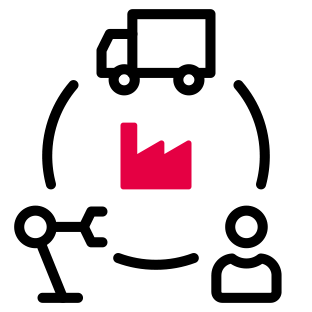 Supply Chain Management (SCM)Read more
Supply Chain Management (SCM)Read more
is the company-wide, process-based planning and management of goods flows, information streams and monetary streams throughout the entire supply chain. SCM extends beyond the company’s boundaries. It connects together areas such as procurement, production, distribution, marketing, controlling, etc. Overarching collaboration, efficient information-sharing and the ability to react fast are some of the essential requirements for successful supply chain management.
 VM as a ServiceRead more
VM as a ServiceRead more
is virtualisation as a service, i.e. providing virtual machines that can be run on conventional PCs. In turn, these virtual machines can be used to run various instances in parallel. This ensures, for example, that entire server landscapes can be relocated with ease, while virtualisation makes software development easier. Depending on the service provider, a virtualisation can take place based on VMware or a virtualisation based on a technology such as OpenStack.





